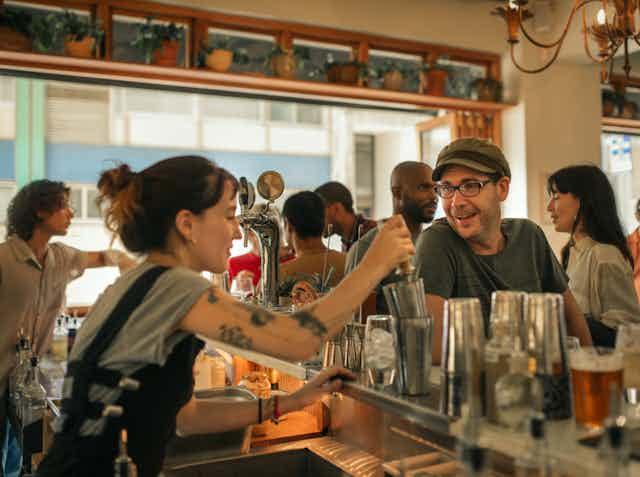As you are reading this, in bars all over the world customers are ordering drinks and bartenders are serving them. Some are getting their drinks without too much fuss, while others are getting disgruntled at being made to wait – and it is even worse when the bartender serves someone who has not been waiting as long as you have. But this common interaction has seldom been explored in any depth.
We used the technique of conversation analysis, developed by Harvey Sacks and inspired by Harold Garfinkel’s ethnomethodology, which enabled us to look in detail at what seem to be fairly mundane everyday interactions.
Our research, which also included analysis of videos showing customers placing requests for drink and food items with bartenders, reveals “best practice” for getting served at the bar. It also shows just how ordered we are in our everyday behaviour.
1: Show that you’re available
As customers, we demonstrate our availability to enter into a spoken, face-to-face service encounter (or not) with our bodies. For example, we might avoid eye contact with or hurry past a street vendor selling the Big Issue if we don’t have change, or make a show of fumbling, when in a shop, with an item that we’d like to speak to a sales assistant about.
And when we’re at the bar we “hover” – a term used elsewhere to describe customers looking for a free table in a cafe. We hover – and we recognise hovering in others. But how? Analysis of 200 customers showed that hovering means standing within two metres of the bar, with your torso aimed in the direction of the bartender, gaze focused on them, taking steps to “move into” an interaction. Standing with your back to the bar, gazing off into the distance or standing more than two metres away is not conducive to speedy service. We have to be available for bartenders to invite us to place an order.
When two or more people come together to interact they engage in a spatial arrangement, a common focus – something Adam Kendon, a scholar of gesture and face-to-face interaction, calls an “O-space”, which helps encourage a transaction such as ordering a drink in the context of a pub.
Note, in the video, the customer’s movements toward the bartender as they negotiate a shared space.
2: Show the money
When the bar is crowded with hovering customers, making ourselves appear to be the “most available” is essential. Bartenders displayed their skill at serving customers in turn, only occasionally inviting a customer to order out of sequence.
Displaying your payment method for your order is an effective way to show you’re not only available to place – but also to pay for – an order. This availability and preparedness makes you an attractive choice in a sea of potential next customers. Analysis revealed this can be done with stacked coins, coins “jingled” in hands, notes and cards. Be sure to keep your gaze at the bartender as interacting with other “objects” in the environment might cost you your turn.
Note the customer as he steps forward, money on display as his competing customer looks down to the menu. This demonstrates he is not yet ready to order – and certainly not ready to exchange a quick payment.
3: Speak up
We routinely visit bars and restaurants with others. When we arrive at a restaurant, we are treated as a group and we tend to have a lead speaker providing the party booking name. We tend to answer collectively, rather than individually to a question: “How’s the food?”
But at the bar, although we arrive as a group, we might wish to place and pay for our orders separately. Or we might order together but pay separately. Sometimes we might order individually but pay together (when one of our friends says “I’ll get these”).
In a busy pub, staff can be put off by a gaggle of customers when they can’t tell who is going to order. So it’s important to make sure whoever is buying the drinks makes themselves obvious. Otherwise it’s quite likely that the bartender will ask whether anyone’s waiting, which might allow someone else to get in first.
4: Have your order ready
These days most pub tills will have separate options for various items, menu choices and the rest – such as a rare, medium or well-done steak – and most cash tills will not allow the order to continue without the option being entered. Or you might be asked to provide a table number if the pub restaurant has waiter service.
So, to make sure this all proceeds without stalling – and to lessen the chances of the bartender drumming his of her fingers on the bar while you shout “chips or salad?” across the pub at your friend, know your table number, know your options and make sure whoever is ordering knows this too.
Cheers!
By now you should have navigated the sea of customers and be sat sipping your drink. What research like this reveals – as well as how to be an efficient customer – is the ordered nature of our everyday behaviours. By looking at mundane activities such as getting served at the bar, we find out more about the practices we employ which produce and maintain this order (and help keep the peace in pubs).
Our analysis also showed what effects our bodies have on getting served next before we even open our mouths. The Daily Telegraph reported in 2013 that German researchers were trying to design a robotic bartender and had used people’s behaviour at the bar as a way to “train” the robots. Whether your smile or stance will cut any ice with these mechanical bartenders remains to be seen, but while humans man the till, these little tips should ensure you don’t go thirsty for long.

